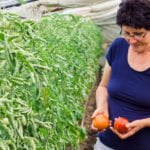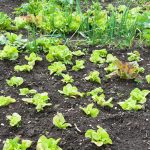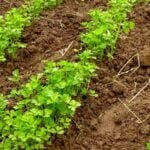Are you a vegetable gardening enthusiast in the Pacific Northwest? The Timber Press Guide to Vegetable Gardening in the Pacific Northwest is a comprehensive resource that will provide you with all the information you need to successfully cultivate a bountiful garden in this unique region. From understanding the climate and soil conditions to dealing with common pest and disease issues, this guide has got you covered.
The Pacific Northwest presents its own set of challenges and rewards for vegetable gardening, and this guide is specifically tailored to address those. Whether you’re a seasoned gardener or just starting out, this guide will help you navigate through the intricacies of gardening in this beautiful region.
With valuable tips on selecting the right vegetables, maximizing your garden’s potential with companion planting and crop rotation, and harvesting and preserving your garden’s bounty, this guide is your go-to companion for successful vegetable gardening in the Pacific Northwest.
In this article, we will delve into key aspects of vegetable gardening covered by the Timber Press Guide, offering valuable insights into understanding the climate and soil conditions specific to the region, selecting suitable vegetables, tips for successful planting and growing, as well as dealing with common pest and disease issues.
So let’s embark on this journey of embracing the unique challenges and rewards of vegetable gardening in the Pacific Northwest with the Timber Press Guide as our trusted companion.
Understanding the Climate and Soil Conditions in the Pacific Northwest
The Timber Press Guide to Vegetable Gardening in the Pacific Northwest offers invaluable insights into the unique climate and soil conditions of this region, helping gardeners make informed choices for their vegetable gardens. The Pacific Northwest is known for its mild, maritime climate, with relatively cool, wet winters and dry summers. This presents both opportunities and challenges for vegetable gardening, as certain crops thrive in these conditions while others may struggle.
The region’s soil also varies widely, from rich, fertile loam to acidic, clayey soil. Understanding the specific characteristics of your garden’s soil is essential for successful vegetable gardening in the Pacific Northwest. The Timber Press Guide provides detailed information on how to assess and improve your soil, ensuring that it provides the necessary nutrients and drainage for your chosen vegetables to flourish.
Furthermore, the book delves into microclimates within the Pacific Northwest, which can significantly impact gardening success. Whether you live near the coast or further inland, understanding these microclimates will help you select the most suitable vegetables and optimize growing conditions in your garden. Overall, the guide equips readers with a comprehensive understanding of the climate and soil conditions in the Pacific Northwest, empowering them to make knowledgeable decisions for their vegetable gardens based on these factors.
Selecting the Right Vegetables for Your Pacific Northwest Garden
When selecting vegetables for your Pacific Northwest garden, consider the following factors:
- Temperature tolerance: Choose vegetables that are well-suited to the cooler temperatures of the region, such as broccoli, kale, and carrots.
- Moisture requirements: Opt for vegetables that can withstand frequent rain and moist soil conditions, such as lettuce, radishes, and peas.
- Sunlight needs: Select vegetables that thrive in partial shade or cooler temperatures, such as spinach, beets, and Swiss chard.
The Timber Press Guide to Vegetable Gardening in the Pacific Northwest also offers insights into heirloom varieties and locally adapted cultivars that are specifically suited to this region. These varieties have been carefully selected and developed to perform well in the unique climate of the Pacific Northwest.
Additionally, the guide provides information on how to extend the growing season by utilizing cold frames or hoop houses to grow a wider variety of vegetables throughout the year. By choosing the right vegetables for your Pacific Northwest garden, you can set yourself up for a successful growing season and enjoy a diverse range of fresh produce from your own backyard.
Tips for Successful Planting and Growing in the Region
When it comes to planting and growing vegetables in the Pacific Northwest, there are a few key tips to keep in mind to ensure a successful garden. The Timber Press Guide to Vegetable Gardening in the Pacific Northwest offers valuable advice for gardeners looking to make the most of their growing season in this unique climate.
Understanding Planting Dates and Seasons
One of the most important factors to consider when planting your vegetable garden in the Pacific Northwest is understanding the region’s distinct planting dates and seasons. The maritime climate of the area means that gardening practices can differ from those in other regions. The Timber Press guide provides insight into the specific timing for planting different vegetables, taking into account both spring and fall growing seasons.
Utilizing Season Extension Techniques
In order to maximize your vegetable garden’s productivity in the Pacific Northwest, it’s essential to utilize season extension techniques. This may include using row covers, cold frames, or hoop houses to protect plants from cool temperatures and extend the growing season. The Timber Press Guide offers practical advice on how to implement these techniques effectively, allowing you to enjoy fresh produce for a longer period of time.
Implementing Proper Watering and Irrigation
Proper watering and irrigation are crucial for successful vegetable gardening in the Pacific Northwest. With its typically mild, wet winters and dry summers, finding the right balance can be challenging. The Timber Press Guide provides insights into efficient watering practices, including drip irrigation systems and mulching techniques that can help conserve water during drier months while ensuring healthy plant growth throughout the year.
Dealing With Common Pest and Disease Issues Specific to the Pacific Northwest
Vegetable gardening in the Pacific Northwest comes with its own set of challenges, particularly when it comes to dealing with pests and diseases. The cool, wet climate of the region can create an environment that is conducive to certain problematic organisms. However, armed with the right knowledge and tools, gardeners can effectively manage these issues and ensure a healthy, thriving garden.
One of the most common pests in the Pacific Northwest is the slug. These slimy creatures thrive in the moist conditions of the region and can quickly decimate young seedlings and tender plants. To combat slugs, it’s important to employ a variety of strategies such as using organic slug bait, creating barriers with copper tape or diatomaceous earth, and encouraging natural predators like ground beetles and birds.
In addition to slugs, other pests like aphids, cabbage moths, and tomato hornworms can also pose problems for Pacific Northwest gardeners. When it comes to diseases, fungal infections such as powdery mildew and blight are prevalent due to the damp climate.
Implementing proper sanitation practices, selecting disease-resistant plant varieties, and practicing crop rotation are crucial steps in preventing these issues. By following the advice laid out in the Timber Press Guide to Vegetable Gardening in the Pacific Northwest, gardeners can effectively address pest and disease challenges while maintaining a thriving vegetable garden.
| Common Pest/Disease | Control Strategies |
|---|---|
| Slugs | Organic slug bait, copper tape barriers, natural predators |
| Aphids | Natural predators such as ladybugs or lacewings, insecticidal soap |
| Powdery Mildew | Selecting resistant plant varieties, proper spacing for air circulation |
Maximizing Your Garden’s Potential With Companion Planting and Crop Rotation
Companion planting and crop rotation are essential practices for maximizing the potential of your vegetable garden in the Pacific Northwest. The Timber Press Guide to Vegetable Gardening in the Pacific Northwest offers valuable insight into how these techniques can benefit your garden and help you achieve a bountiful harvest. By understanding the principles of companion planting and crop rotation, gardeners can create a healthier and more sustainable growing environment for their crops.
Companion planting involves strategically placing different vegetable and plant species next to each other to enhance growth, deter pests, and improve flavor. The Timber Press Guide to Vegetable Gardening in the Pacific Northwest provides detailed recommendations for companion planting combinations that work well in the region’s unique climate and soil conditions. For example, pairing aromatic herbs like basil with tomatoes can help repel pests that commonly affect tomato plants, while also improving the flavor of the tomatoes.
In addition to companion planting, crop rotation is another important technique discussed in the Timber Press guidebook. Crop rotation involves changing the location of vegetable crops within your garden each season to prevent soil depletion and minimize pest and disease problems.
The guide provides specific crop rotation plans tailored to the Pacific Northwest climate, helping gardeners optimize their growing space while maintaining soil health. By incorporating these methods into your gardening practices, you can promote a more diverse ecosystem in your garden while reducing reliance on chemicals and pesticides.
Harvesting and Preserving Your Pacific Northwest Vegetable Garden’s Bounty
Once your vegetables have reached maturity, it’s time to harvest them. The Pacific Northwest climate can be quite mild, allowing for a longer growing season for many vegetables. However, it’s important to keep an eye on the weather patterns, as frost can still occur in some areas.
When harvesting, make sure to use clean and sharp gardening tools to prevent damage to the plants. Some vegetables, like tomatoes and peppers, are best picked when they are fully ripe, while others, such as root vegetables like carrots and beets, can be harvested as needed.
Preserving your vegetable garden’s bounty is a great way to enjoy its produce throughout the year. Canning, pickling, and freezing are popular methods of preserving vegetables in the Pacific Northwest. Canning is a method that requires some specialized equipment but can provide shelf-stable products that last a long time.
Pickling is another great way to preserve excess produce. Vegetables like cucumbers, peppers, and green beans can be pickled in vinegar brine to create tangy and flavorful treats. Freezing is a simple and convenient way to preserve vegetables. Many vegetables can be blanched and then frozen for later use in soups, stews, or casseroles.
It’s important to properly research and follow safe food preservation guidelines when preserving your garden’s bounty. The Timber Press Guide to Vegetable Gardening in the Pacific Northwest offers valuable tips and techniques for successfully preserving your harvest in this unique region.
Resources and Additional Reading for Vegetable Gardening in the Pacific Northwest
When it comes to vegetable gardening in the Pacific Northwest, there are a plethora of resources and additional reading materials that can help both novice and experienced gardeners. One such invaluable resource is the Timber Press Guide to Vegetable Gardening in the Pacific Northwest.
This comprehensive guide offers insights, tips, and expert advice specific to the unique climate and soil conditions of the region. Whether you are looking to start your first garden or are seeking to enhance your gardening skills, this guide is an essential tool for anyone interested in Pacific Northwest vegetable gardening.
In addition to the Timber Press guide, there are numerous other resources available to help gardeners navigate the challenges and maximize the potential of their Pacific Northwest vegetable gardens. Local university extension offices often provide valuable information on planting calendars, soil testing, and pest management specific to the region. Furthermore, joining a local gardening club or attending workshops and seminars can provide opportunities to learn from experienced gardeners and exchange ideas with like-minded individuals.
For those seeking further reading material on vegetable gardening in the Pacific Northwest, there are many books and online resources available. These include guides on organic gardening practices, companion planting techniques, and specific plant varieties that thrive in the region’s climate. By exploring these additional resources, gardeners can expand their knowledge and continue to refine their skills for successful vegetable gardening in the Pacific Northwest.
Conclusion
As any seasoned gardener knows, cultivating a successful vegetable garden requires knowledge, patience, and dedication. However, gardening in the unique climate of the Pacific Northwest presents its own set of challenges and rewards.
The Timber Press Guide to Vegetable Gardening in the Pacific Northwest is an invaluable resource for both novice and experienced gardeners looking to navigate the specific conditions of this region. Whether it’s understanding the climate and soil conditions, selecting the right vegetables, or dealing with pests and diseases, this comprehensive guide provides essential information for maximizing your garden’s potential.
One of the key takeaways from the Timber Press Guide is the emphasis on embracing the unique challenges of gardening in the Pacific Northwest. From the cool, wet winters to the relatively short growing season, this region requires a different approach compared to other parts of the country.
Understanding and adapting to these conditions is crucial for success. The guide offers practical tips for planting and growing in this environment, as well as strategies for maximizing your garden’s productivity through companion planting and crop rotation.
Furthermore, the Timber Press Guide encourages gardeners to not only focus on cultivation but also on preserving their bounty. With helpful guidance on harvesting and preserving techniques specific to vegetables grown in the Pacific Northwest, this resource enables gardeners to enjoy their hard-earned produce throughout the year.
In conclusion, while gardening in this region may present its share of challenges, it also offers immense rewards. The Timber Press Guide equips readers with the knowledge and tools necessary to navigate these challenges effectively and reap a bountiful harvest from their Pacific Northwest vegetable gardens.
Additionally with such a valuable resource at their disposal, gardeners in the Pacific Northwest can confidently embark on their gardening journey knowing they have access to expert advice tailored specifically to their region. From understanding climate and soil conditions to selecting suitable vegetables and dealing with pest issues, the Timber Press Guide is an essential companion for anyone looking to create a thriving vegetable garden in this unique environment.
Frequently Asked Questions
What Is the Most Efficient Vegetable Garden Layout?
The most efficient vegetable garden layout depends on various factors such as the size of the space, the types of vegetables being grown, and the climate. However, a common and efficient layout is the raised bed garden, which maximizes space and allows for better soil management.
How Do You Grow Vegetables in the Pacific Northwest?
Growing vegetables in the Pacific Northwest requires consideration of the region’s unique climate. Gardeners should choose cold-hardy vegetable varieties, utilize season extension techniques such as using row covers or cold frames, and make use of well-draining soil to accommodate the region’s rainy weather.
How Do I Prepare My Land for a Vegetable Garden?
Preparing land for a vegetable garden involves several key steps. These include clearing the area of any debris or weeds, testing and improving soil quality by adding organic matter or fertilizer, planning and marking out the garden beds, and ensuring proper drainage to prevent waterlogging. These preparations are essential for a successful vegetable garden.

If you’re looking to get into vegetable gardening, or are just looking for some tips on how to make your current garden better, then you’ve come to the right place! My name is Ethel and I have been gardening for years. In this blog, I’m going to share with you some of my best tips on how to create a successful vegetable garden.





